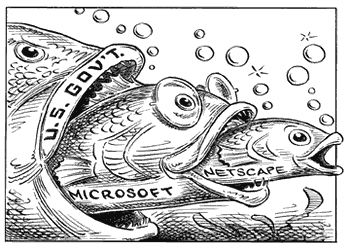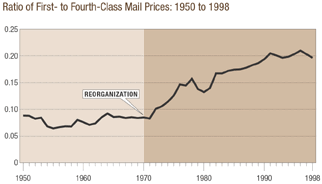- Law & Policy
- Regulation & Property Rights
- Politics, Institutions, and Public Opinion
- Economics
Government and private firms compete with one another in a surprisingly large number of industries. The Tennessee Valley Authority (TVA), the Bonneville Power Authority, and the Salt River Project compete with private electric utilities. TVA has contemplated entering telecommunications and cable television. Amtrak, through its "express freight" service, hauls fruit, paper, auto parts, and other goods, thus competing with railroads and trucking companies. Amtrak also competes with Greyhound and other private bus lines in passenger carriage.
 |
| Illustration by Taylor Jones for the Hoover Digest.
|
The U.S. Postal Service competes directly with United Parcel Service in package delivery and with several other private overnight mail deliveries. The Postal Service also recently formed an alliance with Federal Express, which artificially benefits that company to the exclusion of other private competitors. Fannie Mae and Freddie Mac, both government-sponsored corporations, compete in the mortgage market. Historically, there is even greater competition between government and private firms in countries with more government ownership of industry. Many governments, for example, own airlines that compete directly with their private counterparts.
Government firms enjoy a wide variety of special privileges that artificially improve their competitive advantage. First, government firms often benefit from a legal monopoly in their core business and can use revenues from those monopolies to subsidize competitive activities. Second, government firms are typically exempt from federal, state, and local taxes, which substantially lowers their costs and enhances their ability to price below competitors. Third, government firms may borrow at taxpayer-guaranteed preferential rates, which also artificially reduces costs. Fannie Mae and Freddie Mac operate under federal charters exempting them from state and local corporate income taxes and granting them a $2.25 billion line of credit with the Treasury. The Postal Service retains a $15 billion line of credit. Fourth, government firms often enjoy the power of eminent domain.
Fifth, it is frequently forgotten that taxpayer-owners, who funded the firm’s capital stock, are by definition prohibited from withdrawing their funds from government enterprises in the event of poor firm performance. Government-owned firms are thus absolved from paying dividends or indeed any expected return to shareholders. Conversely, they are free to dissipate owners’ equity through consistent losses over time, which unnaturally lowers their cost of capital relative to a privately owned, publicly traded corporation.
|
"Government firms enjoy an unfair competitive advantage that allows them to set prices below those of more efficient private rivals, forcing out those rivals. Antitrust authorities call that ‘predatory pricing’ when undertaken by private firms but ignore it when it is perpetrated by government firms." |
Sixth, there is a perception that government firms do not face a bankruptcy constraint because they are more likely to be bailed out by the government if they face a financial crisis. The Postal Service, for example, has been technically bankrupt for years but continues to operate. Such implicit government support artificially lowers capital costs even more.
This array of privileges and subsidies allows government firms to set prices below those of more efficient private rivals and enhances their ability to artificially force out those rivals. Antitrust authorities call that "predatory pricing" when undertaken by private firms, and bring legal action, but ignore blatant cases perpetrated by government firms. The effect, however, is the same: more-efficient competitors either don’t enter or are driven from the market.
According to current antitrust reasoning, government-owned firms are uninterested in profits, so they don’t want to drive out competitors. However, managers of government enterprises are very interested in managing big firms (i.e., in maximizing output) for several reasons. Higher output typically leads to larger salaries and greater discretionary budgets for those managers. Managing a larger agency leads to enhanced consulting opportunities for managers after leaving the firm. Larger size increases the manager’s job satisfaction directly if she or he intrinsically values the firm’s output. Larger size is also associated with greater managerial prestige. Higher output provides managers with additional resources with which to placate powerful pressure groups within the firm, such as organized labor. Finally, government managers may be under considerable pressure from members of Congress to continue to serve particular markets, routes, or customer groups. Remaining large helps managers achieve that goal. Although they may not be interested in profits, government firms do value greater output. Government firms thus have both the means and the incentive to engage in predatory pricing.
|
"Because they do not need to maximize profits, government firms are unconcerned about recouping losses. Indeed, they are happy to hold prices below cost indefinitely, since that increases output, which government managers value because it enhances their job security." |
There are two additional reasons, however, why government predation is a cause for concern. First, for predation by a private firm to be rational, that firm must recoup its losses from predation through monopoly prices after it has forced its rivals out. Such monopoly pricing naturally invites additional rivals to enter, making it difficult to recoup losses. Because they do not maximize profits, government firms are unconcerned about recouping losses. Indeed, they are happy to hold prices below cost indefinitely, since that increases output, which government managers value per se for the reasons mentioned above. Rather than simply hoping for higher profits later on, government firms value predation itself, which makes threats from them highly credible.
Second, stockholders of private firms can sell shares when managers engage in wasteful predatory behavior, thus driving down share values. Predatory pricing rarely appeals to private managers because their pay can be linked directly to the stock price (e.g., through options) so they are penalized for indulging in that behavior. Government managers are not similarly subject to stock market discipline.
Pricing by the U.S. Postal Service provides an example of government predation. The Postal Service was restructured extensively as a result of the Postal Reorganization Act of 1970, which virtually eliminated congressional control over the Postal Service but did not replace that oversight with either market or effective regulatory control through the Postal Rate Commission. The commission does not have the power to actually set postal rates. Rather, it only recommends rates to the Postal Service Board of Governors, which can overrule it (which it did in 1981 and again several months ago). Moreover, the commission does not have the power to subpoena information from the Postal Service, which prevents it from conducting its own wide-ranging investigation. Rather, it must rely on testimony brought by intervenors. Third, the commission is weak because of government ownership itself. It cannot reduce the wealth of stockholders by reducing rates. A public utility commission can reduce equity values by refusing to raise rates, by raising them slowly, or by reducing them. This important power places substantial pressure on managers in a private firm because private ownership facilitates strong links between shareholder wealth and the interests of managers, which are eliminated by government ownership.
Fourth, the structure of the ratemaking process prevents the commission from effectively imposing a revenue constraint. The commission must simply take the Postal Service’s costs as given and try to allocate those costs across the various mail classes. Under private ownership, denying rate increases reduces equity. However, the Postal Service can simply claim inability to meet payroll, forcing the commission to raise rates or risk overdrafts. The commission consequently has little power to constrain the costs of the USPS. Overall, the Act effectively transferred control of the Postal Service from Congress to the USPS itself.
 |
Given these institutional arrangements, one would expect the Postal Service to engage in predatory pricing more intensively after the Act than before. Since the Postal Service has a monopoly over letter mail but faces competition from UPS and other services in package delivery (which is a large component of fourth-class mail, recently renamed "Standard Mail (B)"), one would expect it to exploit its monopoly in letter mail but to become predatory in package delivery. Evidence indicates that the Postal Service has done precisely that. The relative price of first- to fourth-class mail rose dramatically after the 1970 reorganization, as shown in the graph above. The ratio of first- to fourth-class mail increased from about 0.085 in 1970 to over 0.20 in 1998, an increase of more than 150 percent. Given that one of the goals of the Act was to reduce the burden placed on first-class mail users, that increase is surprising.
One might expect that firms with such power and incentives would be subject to vigorous regulation. Faith in government ownership, however, has led to the opposite result: nonexistent or very weak antitrust oversight. Commentators have long believed that removing the profit motive would result in firms operating in the "public good." Unfortunately, government enterprises appear to engage in anticompetitive behavior that artificially weakens more efficient private rivals, and society loses overall. It is ironic that the firms deserving the greatest scrutiny are often the government’s own enterprises.







